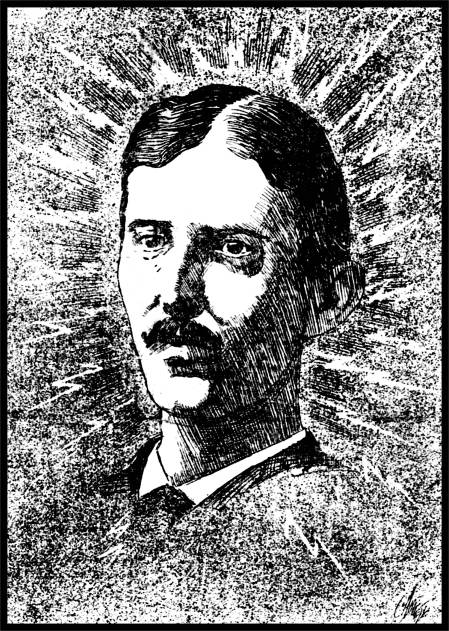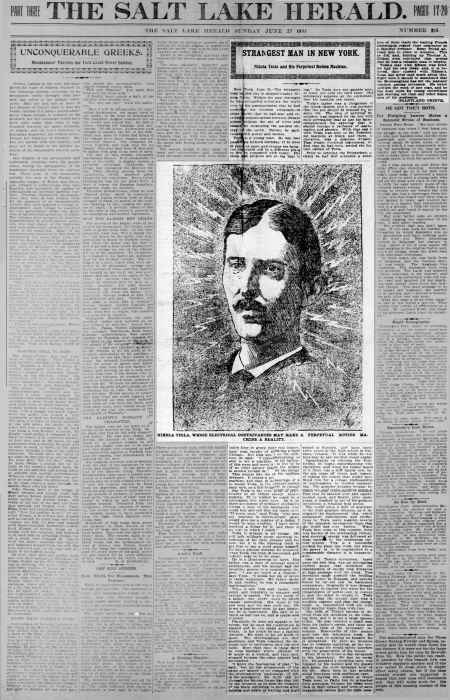Here is a another Tesla articles I came across by accident, thanks to the Library of Congress, regards Arto.
THE SALT LAKE HERALD SUNDAY JUNE 27 1897
STRANGEST MAN IN NEW YORK
Nikola Tesla and His Perpetual Motion Machine
New York June 25 -The strangest man in this city is unquestionably Nikola Tesla. Within the past fortnight he has astounded scientists the world over by his announcement that he had perfected his wireless telegraphy – in other words that he had sent and received communications between distant points without the use of wires and simply employing the natural energy the earth. Nature, he says, teems with power and motion.
Tesla is a young man. He has just past his fortieth birthday. If he lives 20 years or more and retains his faculties the world will be a different place to live in compared with today. His ideas and projects are so big that it takes time to grasp their real import. He talks as calmly of producing a flash of lightning a mile long as the ordinary man speaks of telegraphing to Chicago. Not long ago in his laboratory he said: ”I expect to live to be able to set a machine in the middle of this room and move it by the energy of no other agency than the medium in motion around us.”
This sounds like the vaporings of a dreamer. It means a perpetual motion machine, and that, in itself, is enough to stamp Tesla, in the minds of ordinary men as a full-fledged visionary.
But Tesla is the very acme of practicality in all things except money making. If he wished he could be a millionaire five times over. As it is, there are dozens of ordinary mechanics within a mile of his laboratory who could buy and sell him six times over. “If every man.” said Tesla, “who uses my machine in electro-terafy alone would give me a quarter of a dollar, I would be very wealthy. I have never received a dollar for it, and there is no way in which I could.
Tesla is I strange in all things. He will talk willingly about electrical inventions of the past, present and future, but it is like drawing teeth to him to say a word about himself. He has a genuine distaste for notoriety when Tesla, the man, is concerned, and politely asks to be let alone.
He ts a Montenegran by birth. His father was a man of unusual mental attainments, and his mother had the inventive genius to a considerable degree. “I am not much of a linguist,” says Tesla. “I speak but six or seven or eight languages. My father spoke 18, and, besides, he was a remarkable mathematician.”
Tesla is tall, thin and lanky, but quick and impulsive in manner and earnest in speech. He is not much of a talker, but every word he utters means something. His head is big and bony and his ears stick out. He is not a handsome man, by any means, but he is impressive. His hair is as black as hair can be, and is coarse and rumpled.
Physically he does not appear to he robust, but he says his constitution is rugged and he can stand almost any strain. In his youth he was a famous wrestler. He went in for all kinds of sport. The Montenegrans are rare gamblers, and Tesla inherited the national love of excitement over the card table. More than once in those days he went through single sittings of 48 hours at a stretch, and then only stopped because the other players had succumbed.
“I know the fascination of play,” he said, “but all the allurements of the game are insipid to me compared with the overmastering excitement of life in the laboratory. No thrill can go through the human frame like that felt by the Inventor as he sees the creation of his brain unfolding to success after months and years of waiting and hoping.” So Tesla does not gamble now, at least, not over the card table. His laboratory supplies all the excitement that his emotion can stand.
Tesla’s father was a clergyman of the Greek church, and it was intended that the son should fit himself for the same life. The idea of entering the ministry was opposed by the boy with such pertinacity that at last his father compromised by agreeing that he should become a professor or mathematics and physics. With that end in view Tesla was sent to the Polytechnic institute at Gratz, and there, in operation, was a gramme dynamo. That simple electrical instrument, the first that he had seen, settled the future calling of Tesla.
Prior to entering the Polytechnic at Gratz he had first attended a public school at Gospich, and later spent three years at the high school in Carstatt, Croatia. It was while he was here that he saw his first steam engine.
Immediately on entering the Polytechnic he began experimenting with electricity, and when his father heard of it there was a stiff family row, but the son came off victor, and instead of taking the course that would have fitted him for a college professorship of mathematics, he studied engineering. The gramme dynamo became his great pet, and while working about it he got the notion that it could be operated without commutator or brushes. This idea he labored over and experimented upon and finally after many years, it resulted in one of his greatest inventions, a rotating field motor.
The world owes a debt of gratitude to the little gramme dynamo, as it instigated the fundamental idea which subsequent elaborations and perfections by Tesla made possible several of the grandest mechanical feats that the world has ever known. When Tesla first came to this country, little I was known of the alternating current, and electrical energy was delivered almost entirely by the continuous current system. This is a successful method for short line work, but where the power is to be transmitted to a considerable distance it is impracticable.
One of Tesla’s inventions, based upon his first idea, was an alternating current motor that permitted the transmission of energy long distances at high pressure over the wires. This invention made possible the bridling of the power in Niagara, and natural forces by its use can be harnessed everywhere. Originally it was thought necessary to employ two wires for the transmission of power – one to convey it and the other to return it. Tesla proved that the second wire was a needless expense and that the energy could be transmitted with one wire with smaller waste than with two.
The bulk of Tesla’s income is derived from his invention in the rotating field, and it is not a large income either. He also receives a small sum from his fathers estate, and these are the sum total of his pecuniary resources. Nine-tenths of this money goes into his laboratory work. He spends next to nothing on himself. He is unmarried. He says an inventor has no business marrying, as the necessary home life would surely interfere with the prosecution of his labors.
From 12 to 18 hours a day he spends in his laboratory. He has no social life. He attended a reception once, was lionized by his hostess and the guests and spent the most unhappy hour of his life. Since then he has avoided social functions with assiduous care.
After leaving the school at Gratz Tesla went to Paris, but he attracted little attention, because his Ideas were then in their infancy and were of such magnificent calibre that the mere mention of them made the leading French electricians regard their originator as a fanciful dreamer. Some friend advised him to come to America. This he did, and, hunting up Thomas A. Edison soon convinced that genius that he was a valuable man to employ.
Tesla’s stay with Edison was brief. He had his own ideas, and, it is believed, they clashed with Edison’s. Tesla has never said much about this. Right here it should be mentioned that the Montenegrans has not the jealousy common among inventors. He never belittles the work of any man, and he has done more for young electricians Just starting out than any other dozen men of his profession.
GRANTLAND GRIEVE.
 NIKOLA TESLA, WHOSE ELECTRICAL CONTRIVANCES MAY MAKE A PERPETUAL MOTION MACHINE A REALITY
NIKOLA TESLA, WHOSE ELECTRICAL CONTRIVANCES MAY MAKE A PERPETUAL MOTION MACHINE A REALITY
